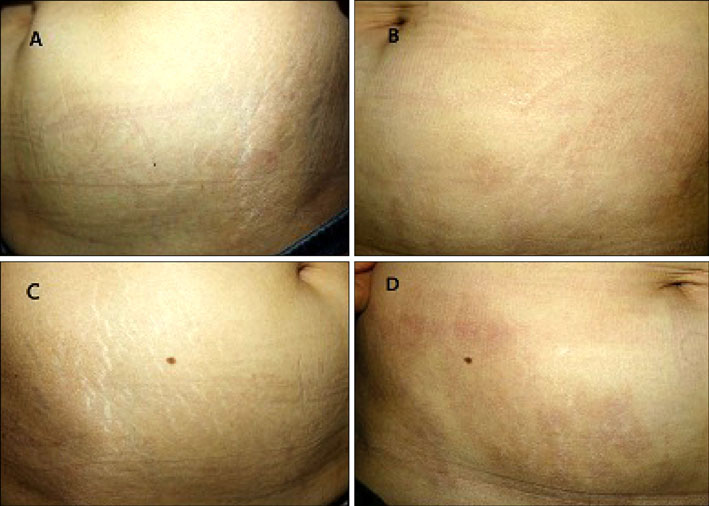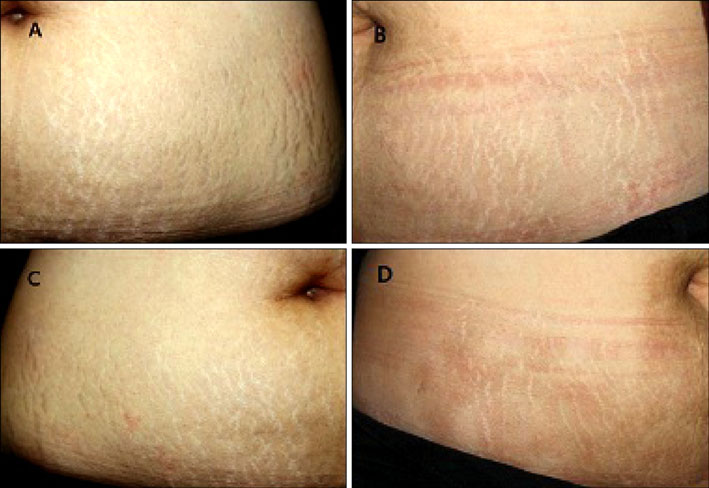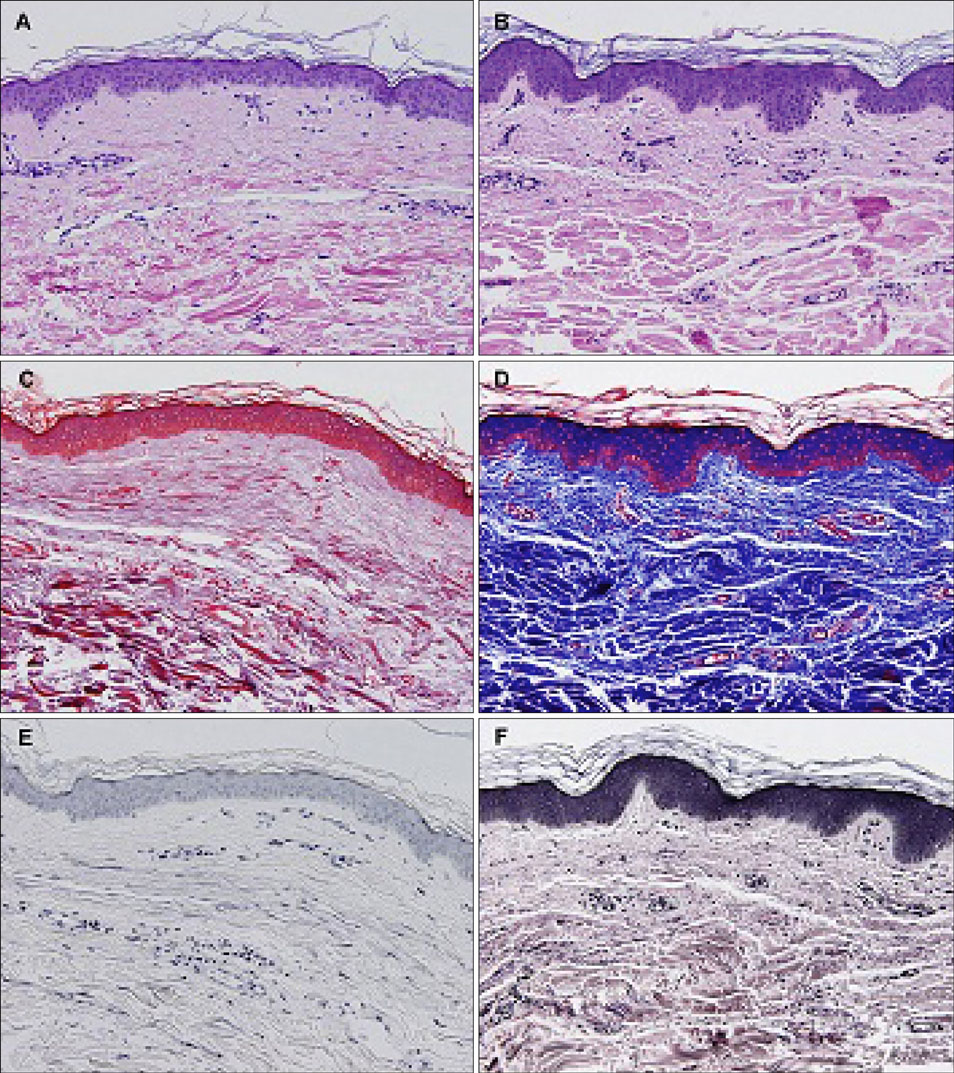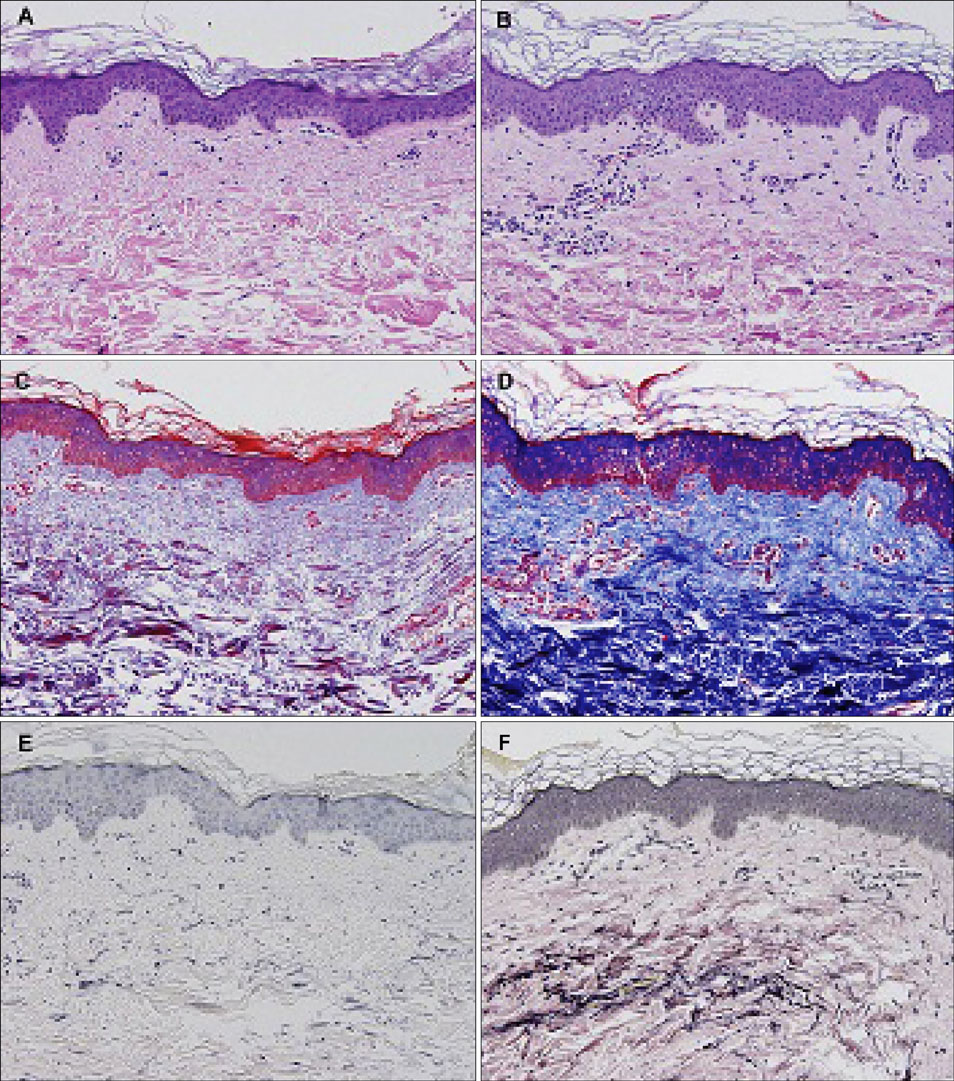Ann Dermatol.
2011 Nov;23(4):481-489.
Treatment of Striae Distensae with Nonablative Fractional Laser versus Ablative CO2 Fractional Laser: A Randomized Controlled Trial
- Affiliations
-
- 1Department of Dermatology, Kangbuk Samsung Hospital, Sungkyunkwan University School of Medicine, Seoul, Korea. gylee0716@daum.net
Abstract
- BACKGROUND
Striae distensae are atrophic dermal scars with overlying epidermal atrophy causing significant cosmetic concern. Although a variety of laser and light sources have been used for the treatment of striae distensae, to date no definite 'gold standard' treatment modality has been determined.
OBJECTIVE
To assess and compare the efficacy and safety of nonablative fractional photothermolysis and ablative CO2 fractional laser resurfacing in the treatment of striae distensae.
METHODS
Twenty-four ethnic South Korean patients with varying degrees of atrophic striae alba in the abdomen were enrolled in a randomized blind split study. The patients were treated with 1,550 nm fractional Er:Glass laser and ablative fractional CO2 laser resurfacing. Each half of the abdominal lesion was randomly selected and treated three times at intervals of 4-weeks using the same parameters. Digital photography was conducted and skin elasticity and the width of the widest striae in each subject were measured at the baseline and 4 weeks after the final treatment. Clinical improvement was assessed by comparing pre- and post-treatment clinical photographs by two blinded physicians and participant satisfaction rates were evaluated. Skin biopsies were taken from three participants. All adverse effects were reported during the study.
RESULTS
Although they do not statistically differ, both treatments with nonablative fractional laser and ablative CO2 fractional laser showed a significant clinical and histopathologic improvement of striae distensae over pretreatment sites.
CONCLUSION
These results support the use of nonablative fractional laser and ablative CO2 fractional laser as effective and safe treatment modalities for striae distensae of Asian skin. However, neither treatment showed any greater clinical improvement than the other treatment.
Keyword
MeSH Terms
Figure
Reference
-
1. Cho S, Park ES, Lee DH, Li K, Chung JH. Clinical features and risk factors for striae distensae in Korean adolescents. J Eur Acad Dermatol Venereol. 2006. 20:1108–1113.
Article2. Atwal GS, Manku LK, Griffiths CE, Polson DW. Striae gravidarum in primiparae. Br J Dermatol. 2006. 155:965–969.
Article3. Kang S, Kim KJ, Griffiths CE, Wong TY, Talwar HS, Fisher GJ, et al. Topical tretinoin (retinoic acid) improves early stretch marks. Arch Dermatol. 1996. 132:519–526.
Article4. Ash K, Lord J, Zukowski M, McDaniel DH. Comparison of topical therapy for striae alba (20% glycolic acid/0.05% tretinoin versus 20% glycolic acid/10% L-ascorbic acid). Dermatol Surg. 1998. 24:849–856.
Article5. McDaniel DH. Laser therapy of stretch marks. Dermatol Clin. 2002. 20:67–76.
Article6. Elsaie ML, Baumann LS, Elsaaiee LT. Striae distensae (stretch marks) and different modalities of therapy: an update. Dermatol Surg. 2009. 35:563–573.7. Nouri K, Romagosa R, Chartier T, Bowes L, Spencer JM. Comparison of the 585 nm pulse dye laser and the short pulsed CO2 laser in the treatment of striae distensae in skin types IV and VI. Dermatol Surg. 1999. 25:368–370.
Article8. Jiménez GP, Flores F, Berman B, Gunja-Smith Z. Treatment of striae rubra and striae alba with the 585-nm pulsed-dye laser. Dermatol Surg. 2003. 29:362–365.
Article9. Hernández-Pérez E, Colombo-Charrier E, Valencia-Ibiett E. Intense pulsed light in the treatment of striae distensae. Dermatol Surg. 2002. 28:1124–1130.
Article10. Alexiades-Armenakas MR, Bernstein LJ, Friedman PM, Geronemus RG. The safety and efficacy of the 308-nm excimer laser for pigment correction of hypopigmented scars and striae alba. Arch Dermatol. 2004. 140:955–960.
Article11. Tay YK, Kwok C, Tan E. Non-ablative 1,450-nm diode laser treatment of striae distensae. Lasers Surg Med. 2006. 38:196–199.
Article12. Suh DH, Chang KY, Son HC, Ryu JH, Lee SJ, Song KY. Radiofrequency and 585-nm pulsed dye laser treatment of striae distensae: a report of 37 Asian patients. Dermatol Surg. 2007. 33:29–34.
Article13. Goldman A, Rossato F, Prati C. Stretch marks: treatment using the 1,064-nm Nd:YAG laser. Dermatol Surg. 2008. 34:686–691.
Article14. Manuskiatti W, Boonthaweeyuwat E, Varothai S. Treatment of striae distensae with a TriPollar radiofrequency device: a pilot study. J Dermatolog Treat. 2009. 20:359–364.
Article15. Kim BJ, Lee DH, Kim MN, Song KY, Cho WI, Lee CK, et al. Fractional photothermolysis for the treatment of striae distensae in Asian skin. Am J Clin Dermatol. 2008. 9:33–37.
Article16. Katz TM, Goldberg LH, Friedman PM. Nonablative fractional photothermolysis for the treatment of striae rubra. Dermatol Surg. 2009. 35:1430–1433.
Article17. Bak H, Kim BJ, Lee WJ, Bang JS, Lee SY, Choi JH, et al. Treatment of striae distensae with fractional photothermolysis. Dermatol Surg. 2009. 35:1215–1220.
Article18. Lee SE, Kim JH, Lee SJ, Lee JE, Kang JM, Kim YK, et al. Treatment of striae distensae using an ablative 10,600-nm carbon dioxide fractional laser: a retrospective review of 27 participants. Dermatol Surg. 2010. 36:1683–1690.
Article19. Shin JU, Roh MR, Rah DK, Ae NK, Suh H, Chung KY. The effect of succinylated atelocollagen and ablative fractional resurfacing laser on striae distensae. J Dermatolog Treat. 2011. 22:113–121.
Article20. Fisher GJ, Varani J, Voorhees JJ. Looking older: fibroblast collapse and therapeutic implications. Arch Dermatol. 2008. 144:666–672.21. Orringer JS, Voorhees JJ, Hamilton T, Hammerberg C, Kang S, Johnson TM, et al. Dermal matrix remodeling after nonablative laser therapy. J Am Acad Dermatol. 2005. 53:775–782.
Article22. Rahman Z, MacFalls H, Jiang K, Chan KF, Kelly K, Tournas J, et al. Fractional deep dermal ablation induces tissue tightening. Lasers Surg Med. 2009. 41:78–86.
Article23. Hantash BM, Bedi VP, Kapadia B, Rahman Z, Jiang K, Tanner H, et al. In vivo histological evaluation of a novel ablative fractional resurfacing device. Lasers Surg Med. 2007. 39:96–107.
Article
- Full Text Links
- Actions
-
Cited
- CITED
-
- Close
- Share
- Similar articles
-
- Treatment of Striae Distensae by Thermage and 585-nm Pulsed Dye Laser(V-star(R))
- A Randomized Split-face Study Comparing the Efficacy of Combined-diode Laser/Bipolar Radiofrequency (PolarisTM) vs. Combined-diode Laser/Bipolar Radiofrequency (PolarisTM) Combined with a Non-ablative 1,550-nm Fractional Erbium-glass
- Efficacy of Early Application of Ablative Fractional CO2 Laser on Secondary Skin Contracture after Skin Graft
- Comparison of the Effectiveness of Ablative and Non-Ablative Fractional Laser Treatments for Early Stage Thyroidectomy Scars
- Insight into Striae Distensae with Cosmetic Concern in Korean Women





